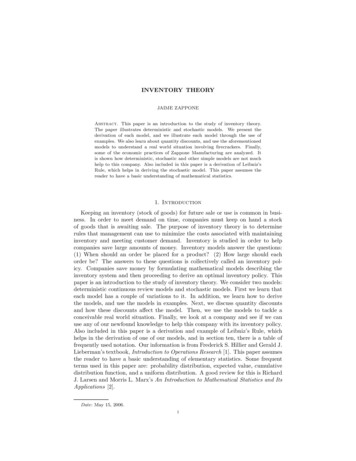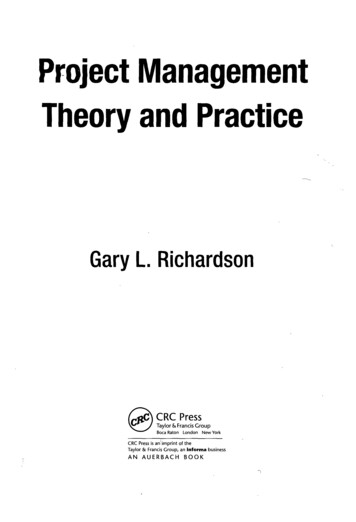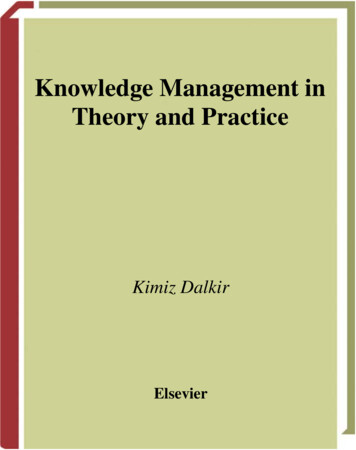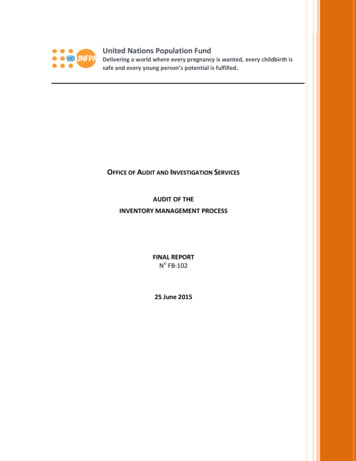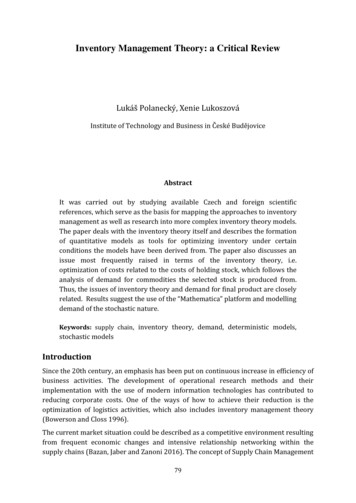
Transcription
Inventory Management Theory: a Critical ReviewLukáš Polanecký, Xenie LukoszováInstitute of Technology and Business in České BudějoviceAbstractIt was carried out by studying available Czech and foreign scientificreferences, which serve as the basis for mapping the approaches to inventorymanagement as well as research into more complex inventory theory models.The paper deals with the inventory theory itself and describes the formationof quantitative models as tools for optimizing inventory under certainconditions the models have been derived from. The paper also discusses anissue most frequently raised in terms of the inventory theory, i.e.optimization of costs related to the costs of holding stock, which follows theanalysis of demand for commodities the selected stock is produced from.Thus, the issues of inventory theory and demand for final product are closelyrelated. Results suggest the use of the “Mathematica” platform and modellingdemand of the stochastic nature.Keywords: supply chain, inventory theory, demand, deterministic models,stochastic modelsIntroductionSince the 20th century, an emphasis has been put on continuous increase in efficiency ofbusiness activities. The development of operational research methods and theirimplementation with the use of modern information technologies has contributed toreducing corporate costs. One of the ways of how to achieve their reduction is theoptimization of logistics activities, which also includes inventory management theory(Bowerson and Closs 1996).The current market situation could be described as a competitive environment resultingfrom frequent economic changes and intensive relationship networking within thesupply chains (Bazan, Jaber and Zanoni 2016). The concept of Supply Chain Management79
Littera Scripta, 2016, Volume 9, Issue 2first appeared in the mid-1990s (Sixta and Žižka 2009). Kuncová (2009) states that thesupply chain management is currently one of the most developing areas. For mostcompanies, entering these supply chains has been becoming a routine, graduallyimposed by the market and the conditions of such companies. An essential condition inthis context is to use the latest technologies for a quick information and data interchangebetween customers and suppliers. Mutual cooperation and collaboration of the supplychain members, including sharing information, are the driving factors ensuring a highercompetitiveness in the market as well as a larger scope of activities in the market bothfor the companies and the whole chains (Lee, Chan and Langevin 2016). Due to thecontinuously growing customers demands, the limiting and decisive factor is not onlythe price or quality of the product, but also lead time, services provided by the producerand/or the customers relationship to the company and the product(s). As a result ofthese requirements, companies currently engage more in the supply chains and theirmutual cooperation can generate far more benefits than their mutual competitiveness(Basl, Majer, Šmíra 2003). The main objective of the supply chain management is to stayone step ahead of the competitors and a great emphasis is also put on the informationinvolving demand (the number of items sold, sellers expectations, predictingcustomers behaviour, various marketing actions, competition). An important role of theinventory theory is to satisfy the demand and determine its further development as wellas to ensure an adequate quantity of the goods (Daněk and Plevný 2005).In the supply chain, inventory (or stock) has an important role from a commercial pointof view. There is a wide range of factors affecting the supply chain, such as the stocklevel throughout the whole supply chain (and not only in a particular entity), costsrelated to storing and maintaining the inventory, in particular their minimization in thewhole supply chain, and at the same time, the pursuit of maximum demand satisfaction(Samal and Pratihar 2014). Inventory management is an important element both in themanagement of individual companies and the supply chains as such. Regardless ofwhether the inventory refers to raw materials, material, semi-finished or finishedproducts, it is an element which influences the operations of companies and supplychains, and should therefore be given adequate attention. Owing to frequentuncertainties in the market development, fluctuating demand or production andchanges in lead times, the inventory management as such may be very complicated(Emmett 2008). There is no universal model, with a wide range of factors affecting theinventory stock, and thus the situation here is closely related to the ability to predict thefuture consumption induced by future demand (Bartmann and Beckamann 1992). Thefuture demand varies in the course of time and is covered by the production, which, bycontrast, remains constant, and any changes that do occur are step changes rather thanincremental ones. In this case, the inventory serves to compensate for the differencesbetween the productive potential and the demand volume (Lukáš 2009). The goal of thepaper is to critically review methods of Inventory management theory. The scope of thispaper is based on collection of methods which were derived form a comprehensive workof Lukáš (2005a, 2005b, 2009, 2012, and 2016) who deals with probability models in80
Littera Scripta, 2016, Volume 9, Issue 2detailed fashion. The value added is in comparison of the method which is based on thecomparison of practical usefulness and academic value measured by publications.Materials and MethodsA detailed mathematical analysis of the deterministic and stochastic models isconducted to classify and identify the methods. Current usability of the methods ismeasured by their publication frequency in databases, such as “Web of Science,ProQuest, Scopus, and ScienceDirect“. Based on the classification of such models, thestudy examines the application of cost models, stochastic demand and also theapproaches within the deterministic models. The authors focus on the modelsconcerning the field of operational research, specifically the inventory theory. Theoperational research can be characterized as a set of relatively independent areas aimedat the analysis of various types of decision problems. The inventory theory as such is oneof the operational research areas.The authors have used the methods known as mathematical programming methods(mainly linear and nonlinear programming, stochastic programming and dynamicprogramming), which are essential for the research and analysis here. The methods usedalso include simulation procedures and techniques.Other objective is a detailed mathematical analysis of the deterministic and stochasticmodels and the identification of their current usability by means of publicationoutcomes in scientific databases, such as “Web of Science, ProQuest, Scopus, Web ofKnowledge, ScienceDirect“. Those models are predominantly the outputs of specificplatforms, such as “Matlab, Mathematica”, more specifically by means of m-files, or theprogrammes for Inventory Control or Stochastic Inventory Control.In order to carry out this study, the authors used a method of analysis and synthesis ofselected articles and papers, available from the aforementioned databases. The authorsmainly drew their attention to the works by Lukáš (2005a, 2005b, 2009, 2012, and2016), and by Bowersox, Closse (1996), Bazana, Jabera and Zazoni (2016), and by Lee,Chan and Langevin (2016) .ResultsIn this part classification of the inventory theory models is presented. The businesssector representatives will be able to use this classification to optimize their inventoriesas well as their subsequent warehouse inventory management.81
Littera Scripta, 2016, Volume 9, Issue 2Tab. 1: Publications of models of inventory theoryDeterministic modelsConstantCombinedStochastic modelsSingleMultiproductproductPublications in databases- Applicability in practice- Mathematica – software- Matlab – software- Source: Authors own compilationTable 1 lists the models of inventory management theory, which can be modelled usingmathematical tools and the necessary software. The authors present two basicdescriptions of demand, which also separate and refer to the two models of inventorytheory - "Deterministic models“ and “Stochastic models." The authors focused on thepublications of each model in various scientific databases to verify the availability ofscientific studies by individual authors. Based on this analysis, they discovered that thehighest number of published sources, while also applicable to business practice, isrepresented by the models of stochastic demand description, with multiple-productmodels being the most usable in terms of their variability as well as being the mostcustomizable to modelling capabilities by responding to different situations that mayarise on the market in various sectors. Essentially, this is demand for certain goodsavailable on the market for given manufacturing companies, which thus ensuredcontinuity of production even over a period with certain unforeseen situations, e.g.traffic problems during shipment and transport of goods necessary for the productioncycle and production procurement.Within a practical context, there are only a few situations that would correspond to apurely deterministic model. If they do occur, it is either in combination with anothermodel of stochastic nature, or as an approximation of the stochastic model with verylittle dispersion. Also, the deterministic models usually serve as the fundamental basis ofcomplex, stochastic models of inventory management. The above table also shows thaton analysing the scientific studies, the authors most frequently came across the use ofmodelling platforms (software) that the studies authors applied to modellingappropriate situations in the form of the "Mathematica" platform. In comparison withthe "Matlab" platform, this software is easier to use and is characterized by itsvariability. Additionally, models describing the stochastic demand (specifically themulti-product ones) are the most common variant of modelling in this platform. Theseaspects of applying individual platforms are quite the measure of usability(applicability) of modelled situations in the form of a particular model in practice, wherethe situations are modelled on data of specific companies and capture their desiredoptimization conditions.82
Littera Scripta, 2016, Volume 9, Issue 2DiscussionThe main contribution of this part should be the analysis, characterisation andderivation of the inventory theory models, which the business sector representativeswill be able to use to optimize their inventories as well as their subsequent warehouseinventory management.Inventory theory modelsThe knowledge and character of demand are very important for the whole inventorymanagement. There are basically three demand modelling methods. One of them is thedeterministic demand model, where its explicit expression is known. The demandfunction may not only be a linear demand function, but also the polynomial of generaldegree n function, or any other known function. It merely depends on the real situationto be modelled (Lukáš 2005).As for the deterministic inventory models, the demand function may either be estimatedor approximated. These inventory models are based on the assumptions that both thedemand volume and procurement cycle are predetermined. Knowing the exact volumeof needs to be met out of inventories, even notwithstanding the random variations indeliveries from suppliers, it is pointless to create any safety stock. Therefore, all of thedeterministic models only optimize certain inventory turnover ratio and a cost optimumis searched only by means of storage costs and one-off costs to replenish inventory(Jablonský 2007, Lukáš 2005, Kořenář 2002, Lysina 2000).Deterministic demand function as a modelIn order to solve these models, (rather than the simulation methods) other optimizationtechniques are preferably used. For example, to solve the deterministic model with aconstant need, the Harris-Wilson formula may be applied for determining (calculating)the optimal supply. Other deterministic inventory models include the EOQ (EconomicOrder Quantity) model, which is based on periodic replenishment at uniform demandand constant rate of supply (Lukáš 2012):𝐶𝑁(𝑞) 𝑉𝑁 𝐹𝑁 𝑐1 𝑞2 𝑐2 𝑄(1)𝑞Here, an order size, or order quantity (q), is the model variable. Therefore, to find outthe function s minimum value, the first derivative (according to q) may equal to zero.Calculating (determining) the optimal order quantity (q*) formula may then be obtainedas follows:𝑞 2 𝑄 𝑐1(2)𝑐2complemented by the following formula for determining the total minimum cost:𝐶𝑁 2 𝑄 𝑐1 𝑐2(3)83
Littera Scripta, 2016, Volume 9, Issue 2Based on these data, it is also possible to obtain the optimal replenishment cycle length(or time) (t*):2 c𝑡 Q c2(4)1and the reorder point (rp*), which indicates at which level of items in stock an order isto be placed to replenish that particular stock at a given (or desired) point – i.e. whenrunning out of inventory:𝑟𝑝 (𝑄 𝐿)𝑚𝑜𝑑 𝑞 (5)Modifications of this model include the "Model of delayed demand satisfaction", whichallows even for a temporary shortage of stock and delayed demand satisfaction, the "EPL(Economic Production Lot-Size)" model, where the make-to-stock production phase andthe use-up-the-stock phase (or only the latter) follow each other, and the "Model ofquantitative rebate", when the calculation also includes quantitative rebates fromsuppliers (Giri, Chaudhuri 1998):𝑞 𝑧𝑧𝑉𝑁𝑡 𝑐1 2 𝑡1 𝑐3 2 𝑡2(6)Here, the number of order cycles is given again by the ratio of total demand to the orderquantity, i.e. Q/q. Fixed costs may then be obtained by multiplying the number of orderswith the c2 constant (cost per order). Consequently, the total annual cost of inventorymay be obtained in the following manner:𝐶𝑁 𝑉𝑁 𝐹𝑁 𝑐2 𝑐3 𝑧2 𝑡2 ) 𝑄𝑞 (𝑐1 𝑞 𝑧2 𝑡1 𝑐3 𝑄𝑧2 𝑡2 ) 𝑄𝑞 (𝑐1 𝑞 𝑧2 𝑡1 𝑐2 (7)𝑞The above function is of four variables, which through mutual substitution may bereduced down to two, i.e. the order quantity (q) and the unsatisfied inventory size orquantity (z). Partial derivative (Ter-Manuelianc 1980, Jablonský 2007) will result in theoptimal order quantity and the unsatisfied demand size (or quantity):2 𝑄 𝑐2𝑞 𝑧 𝑞 𝑐1𝑐1 𝑐3 (8)𝑐3𝑐1 𝑐3(9)𝑐3The optimal order quantity is therefore derived from the value obtained in the basicEOQ model by multiplying both of the constants dependent on the storage costs (c1) andthe costs associated with shortage of stock (c3). However, if the c3 costs aredisproportionately higher than the storage costs (which could often be anticipated,particularly when recognizing the customer’s potential loss), then this constantapproximately equals one and the shortage of stock is basically not considered. As aresult, it is the return to the basic EOQ model.84
Littera Scripta, 2016, Volume 9, Issue 2Stochastic inventory models differ from the deterministic ones only in the character ofdemand. Whilst demand is fixed in the deterministic models, demand in the former is ofstochastic (probabilistic) nature, which means it is a random variable with a probabilitydistribution. The stochastic models represent a certain demand, where its explicitexpression is known. The demand function may include not only a linear function, butalso a function with a polynomial of general degree n, or any other known function. It ismerely dependent on the real situation to be modelled (Kořenář 2010).As for the static stochastic modelling, the main prerequisite here is the impossibility offurther inventory replenishment. Therefore, these are situations, where over a certainperiod it is necessary to satisfy the needs from the stock that can be created only once. Ifthe generated stock is lower than the actual need, certain costs from a shortage of stockwill emerge. On the contrary, provided that the generated stock is higher than the actualneed, some additional costs will be incurred again, for after the end of the period, thestock will not be usable (e.g. a Christmas tree retailer).Static stochastic demand description as a modelThese are models often used for a single replenishment, mostly with sporadic demand(i.e. Lumpy Demand). The aim of these models is to find the lowest value of the total costfor the delivery of q xi volume. The lowest value may be obtained by searchingprogressive values:𝐸(𝑁(𝑞 𝑥𝑖 1 )) 𝐸(𝑁(𝑞 𝑥𝑖 𝑞0 )) 𝐸(𝑁(𝑞 𝑥𝑖 1 ))(10)By determining three values in 𝐸(𝑁(𝑞)) 𝑝𝑟𝑜𝑞 {𝑥𝑖 1 , 𝑥𝑖 , 𝑥𝑖 1 }, a local minimum isobtained, thus the lowest actual cost for q xi. The mean value for 𝐸(𝑁(𝑞)) may bedetermined through (Lukáš, 2005):𝑛𝐸(𝑁(𝑞)) 𝐶1 𝑖 1(11)𝑗 0(𝑞 𝑥𝑗 ) 𝑝 (𝑥𝑗 ) 𝐶2 𝑗 𝑖 1(𝑥𝑗 𝑞) 𝑝 (𝑥𝑗 )Dynamic stochastic demand description as a modelThe most common assumption is that the demand distribution in a given period followsa normal distribution with a mean value (μQ) and a standard deviation (σQ). Likewise,demand during a particular lead time (L) is normally distributed with a mean value (μL)and a variance (σL), where:𝜇𝐿 𝐿 𝜇𝑄(12)𝜎𝐿 𝐿 𝜎𝑄(13)Owing to the probabilistic nature of demand, all of the available inventories may notnecessarily be used up during the lead time, but two cases may occur - upon the arrivalof the ordered goods, there are still some items in stock, or there is a shortage of stockduring the lead time. One way to find out is to determine the level of safety stock.85
Littera Scripta, 2016, Volume 9, Issue 2The safety stock level (or quantity) can be determined in many ways (Kutiš, 2004), withthe majority of them working with the assumption of stochastic lead time. The followingtext merely indicates determining the minimum safety stock based on demand during aconstant lead time (L). Assuming that during the acquisition (lead) time the demand hasa normal distribution with a mean value (μL) and a variance (σL) and knowing aprobability (γ), which corresponds to a value of the distribution function of a standardnormal distribution (zγ), then the following should apply:𝑤 𝑧𝛾 𝜎𝐿(14)The new reorder point (rw) can then be obtained by increasing the original point (rp*)by a value of safety stock (w), thus reading:𝑟𝑤 𝑤 (𝑄 𝐿 (𝑚𝑜𝑑 𝑞))(15)where the mod function represents a particular remainder after the whole numberdivision.Another option is to exactly determine the safety stock level with the help of lead time,but this procedure is not suitable for a lead time shorter than one period. The functionsthen take the following form:𝑤 𝑧𝛾 𝜎𝑄 𝐿(16)𝑟𝑤 𝐿 𝜇𝑄 𝑤(17)In this case it is possible to obtain the optimal order quantity in a similar way to thedeterministic EOQ model, which is:2 𝜇𝑄 𝑐2𝑞 (18)𝑐1The total costs are also similar. However, it is necessary to extend them by the costs ofsafety stock holding:𝐶𝑁 2 𝑄 𝑐1 𝑐2 𝑐1 𝑤(19)ConclusionThis study described selected issues of supply chains and summarized the basicmanagement concepts that have evolved over time and have had an influence onforming the methods for supply chain management in the view of the inventory theory.Inventory management may use either the already developed mathematical models orsome of the managerial control concepts mentioned here, and last but not least, thesimulation models as well. The most familiar mathematical model is the EOQ (EconomicOrder Quantity) model, which defines the methods for determining both the orderquantity and lead time in order to minimize the inventory costs. It is also possible to usea variety of methods to estimate demand. Most frequently, they encompass certainpredictions based on the trends and developments in the previous period (i.e. using86
Littera Scripta, 2016, Volume 9, Issue 2statistical methods and estimates), or on the econometric models, which include themost important factors affecting th
Inventory management is an important element both in the management of individual companies and the supply chains as such. Regardless of whether the inventory refers to raw materials, material, semi-finished or finished . models being the most usable in



